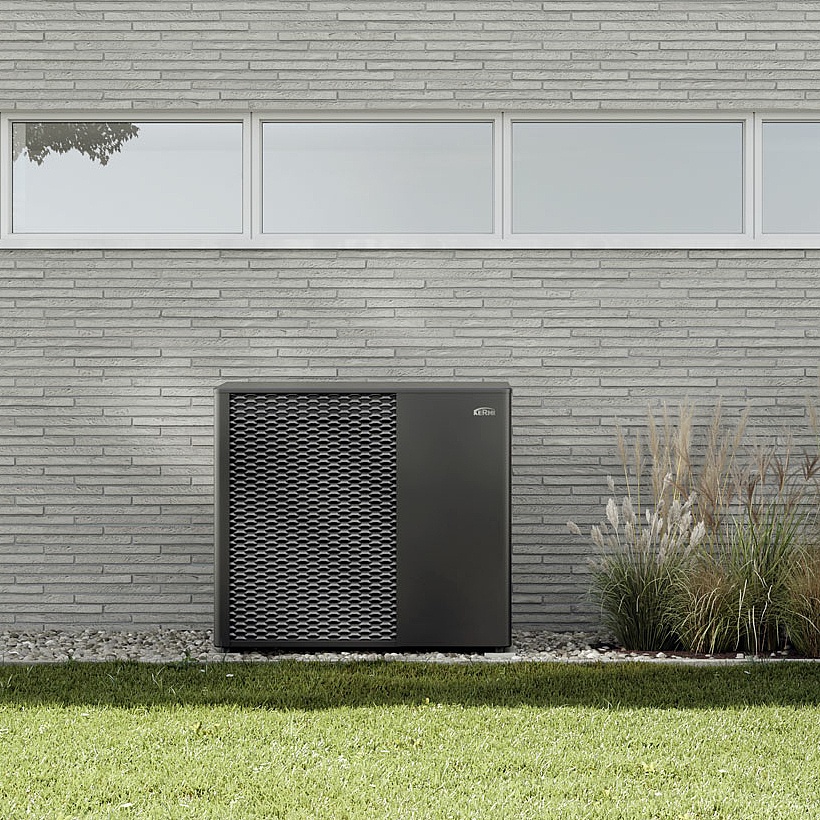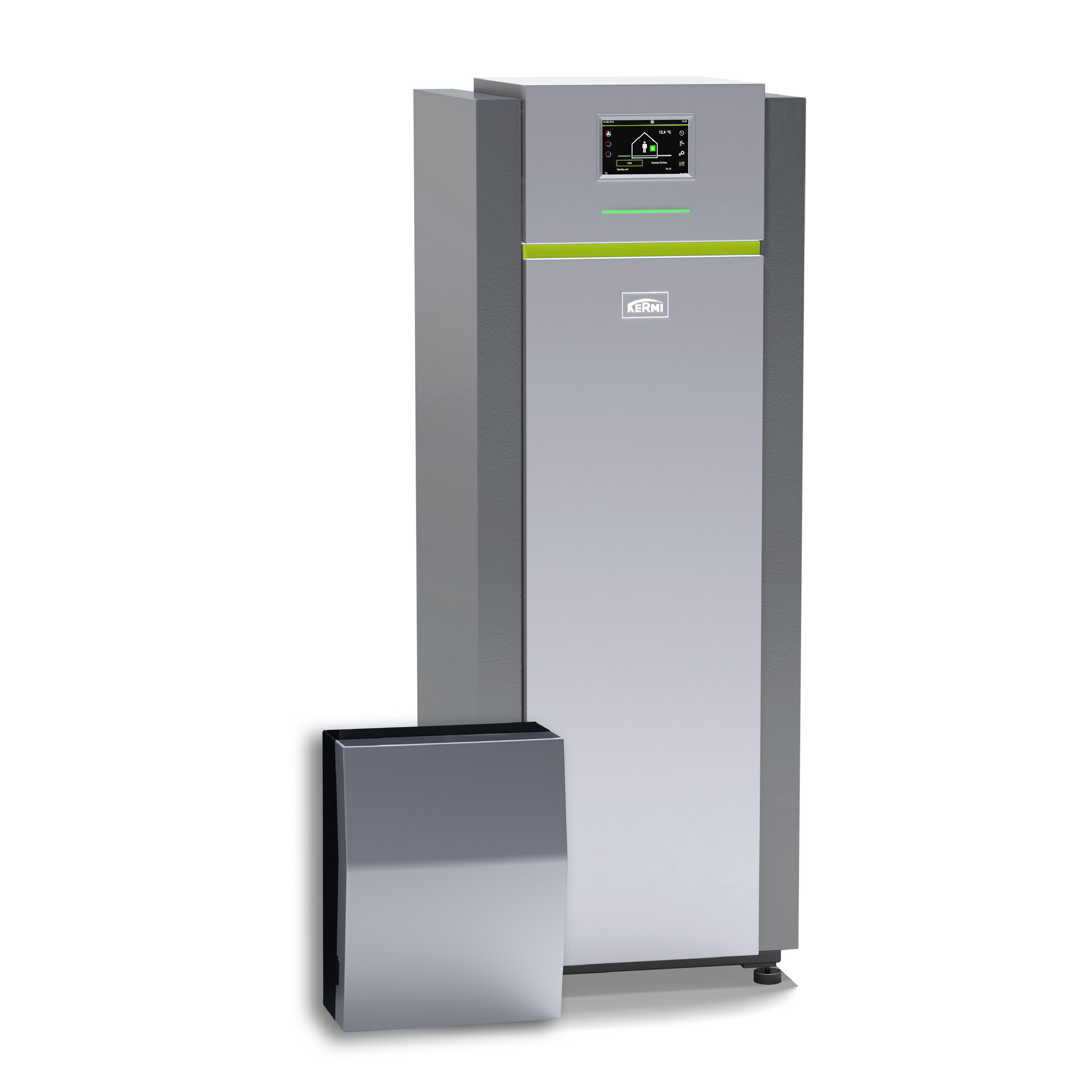KERMI heat pumps
Efficient heating and cooling with future-proof technology

Free warranty package worth 3,000 euros!

Seven-year warranty and service for your heat pump - free of charge! Including repairs, maintenance, efficiency analyses and much more.
Find out how to get our "all-round carefree package" here
KERMI heat pumps: quality, efficiency and comfort.
Heat pumps provide excellent living comfort in a completely natural way. And they do this particularly efficiently and therefore cost-effectively by utilising free regenerative energy from the ground, groundwater or the air. In the large Kermi x-change heat pump range you will find the optimum solution for new builds and modernisation projects.
When it comes to future-proof heating, Kermi heat pumps are the first choice. Trust in innovative technology and decades of experience.
Is my house suitable for a heat pump?

Many homeowners ask themselves whether a heat pump is suitable for their existing building. Modern heat pumps are flexible and designed for a wide range of requirements. Whether energy refurbishment or heating replacement, a suitable heat pump solution helps to save energy, protect the environment and increase property value. The optimum heating solution always requires individual consideration of the house.
Do I necessarily need underfloor heating?
No. Modern heat pumps are designed so that they can also work efficiently with existing radiators in existing buildings. The type and size of the radiators play a role here. If necessary, they can be replaced by heat pump radiators which are optimised for lower flow temperatures.
Is insulation necessary?
Good insulation increases the efficiency of any heating system, including that of a heat pump. However, it is not always essential for the successful installation of a heat pump. Modern heat pumps can also be a sensible and efficient heating solution in existing buildings with less insulation.
How high is the flow temperature for radiators?
Heat pumps work most efficiently at lower flow temperatures. Underfloor heating is therefore ideal as it operates at low temperatures. For radiators in existing buildings, the required flow temperatures can be between approx. 35 °C and 55 °C, depending on the heat pump model and the dimensions of the heating surfaces. An individual analysis of the heating system is crucial here.
What does a heat pump cost?

Investing in a heat pump is a decisive step towards a future-proof heating solution. Without gas or oil.
How high are the purchase costs?
The acquisition costs for a heat pump, including installation, vary depending on the type of heat pump and the installation effort. They are approximately between 20,000 and 40,000 euros.
What are the ongoing operating costs?
As a heat pump heats with electricity, the ongoing operating costs depend on electricity consumption. An important value here is the annual COP (JAZ). It shows how much heat the heat pump generates from one kilowatt hour of electricity. For example, a seasonal performance factor of 4 means that 4 kWh of heat are generated from 1 kWh of electricity. The higher the SPF, the lower the electricity costs. The SPF is always calculated over an entire year and takes into account the specific conditions of the building. An individual calculation is therefore important for each building.
When does a heat pump pay for itself?
In the long term, investing in a heat pump pays for itself. Due to the generally significantly lower operating costs compared to conventional heating systems using gas and heating oil, it leads to sustainable savings. The free electricity from a PV system can further reduce operating costs and shorten the amortisation period.
What subsidies are available for heat pumps?
The current Building Energy Act (GEG) provides for a basic subsidy of at least 30 per cent of the investment costs. In addition, there is a climate speed bonus of 20 per cent until the end of 2028 if an old, still functional heating system is replaced. For households with an annual taxable income of up to 40,000 euros, there is an income bonus that can increase the subsidy to up to 70 per cent.
How does a heat pump work?

In principle, a heat pump works like a refrigerator, only in the other direction. While the refrigerator extracts heat from its contents and releases it to the outside, the heat pump extracts energy from the ambient air, the ground or the groundwater, for example, and releases it to the heating system.
There are 3 main steps involved:
1. extracting heat
Depending on the type of heat pump, energy is extracted from the ambient air, the ground or the groundwater. This is done either by a fan (air heat pumps) that draws in ambient air or, in the case of brine heat pumps, via probes or collectors in which the brine circulates and extracts heat from the environment.
2. compressing heat
The energy obtained is now transferred in the heat pump via a heat exchanger to a second, independent circuit in which an environmentally friendly refrigerant circulates - just like in a refrigerator. The refrigerant evaporates through heating. Compression in a compressor causes the temperature of the refrigerant to rise significantly. This heat is then extracted from the refrigerant via another heat exchanger and transferred to the heating system. The refrigerant condenses and is thus returned to the cycle.
3. distribute & store heat
The energy that the refrigerant releases to the (central) heating system via the second heat exchanger is transferred there in the form of heated water to radiators, underfloor heating etc. or stored temporarily in a storage system such as a buffer storage or hot water storage tank.
What are the benefits of a heat pump?
Low space requirements
Oil or gas tanks, and bunkers for pellets or wood chips, all need plenty of space – something that comes at a premium in old and new buildings alike. In addition to the space requirements, it is important to consider the odours that oil and other sources emit – we are all familiar with the typical smell of a boiler room. With a heat pump, however, none of this is needs to be considered.
Heating and cooling with a single unit
As mentioned previously, a heat pump operating in heating mode works in the same way as a refrigerator, only in reverse. This can be switched around in the summer, of course, allowing the heat pump to operate in cooling mode on hot days – for example, in combination with x–net panel heating and surface cooling.
Virtually no maintenance costs
Heat pumps are extremely easy to maintain and need very little attention. They contain mature technology that has gone the distance, putting them light years ahead of many other heating systems when it comes to durability and maintainability. Heat pumps do not suffer from a gradual loss of performance: whether it is the first day of using them or they have been in operation for 25 years, their output always remains the same.
No emissions, no chimney sweeps
You don’t need a chimney if there are no emissions. And without a chimney, you don’t need an annual visit from a chimney sweep. That’s not just a good thing for the environment – your wallet will thank you too.
Controlling your heat pump intelligently and conveniently
The technology in a heat pump can be controlled with precision. That creates the perfect conditions for intelligent control with smart home applications and apps – delivering not only greater comfort, but also more potential for savings.
Completely independent with solar power
If you operate your heat pump with electricity you have generated yourself (from a solar panel system, for instance) and you use intelligent control, you no longer have to worry about oil, gas, electricity, and wood prices – instead, you’ll be generating electricity at virtually zero cost.
Specialist heat pump terminology
Explained simply
Monovalent operation
The heat pump is the only heat generator in the building.
Monoenergetic operation
The heat pump operates up to a predefined outside temperature. If the outside temperature is lower than this, an electric screw-in heater switches on; like the heat pump, this is operated using electricity.
Bivalent operation
There is a second heat generator that works either in parallel (bivalent-parallel) or alternately (bivalent-alternative) with the heat pump.
In bivalent-parallel operation, both heat sources work in parallel at a predefined outside temperature. If the heat generators run bivalent-alternatively, then they operate alternately.
Coefficient of performance (COP)
The coefficient of performance (or COP* for short) of a heat pump is a parameter determined under standardised test conditions and indicates the output of a heat pump. The COP is suitable for an initial comparison of different models and provides an insight into their output and the heat source used.
Although initially somewhat cryptic-looking, the sequence of numbers and letters is actually quite easy to decipher.
The letters A, B, and W stand for the terms air, brine, and water respectively. Assuming a COP of B2W35 for our heat pump, this would mean that a brine heat pump at 2 degrees brine temperature would generate hot water at a temperature of 35 degrees under normal conditions.
Annual COP (ACOP)
The annual COP (Annual COP*) compares the energy generated with the energy required to do so, providing an efficiency factor. The higher the annual COP, the more efficient the heat pump is.
Depending on the heat source, the annual COP is usually between 3.5 and around 4.5; that is, a kilowatt hour of electricity is converted into between 3.5 and 4.5 kilowatt hours of heat output.
Modulation / modulierend
Eine modulierende (leistungsgeregelte) Wärmepumpe kann ihre Heizleistung an den Wärmebedarf eines Gebäudes anpassen. Dadurch kann die Wärmepumpe leiser und effizienter arbeiten und sich optimal an unterschiedliche Außentemperaturen anpassen.
Buy a KERMI heat pump
We attach great importance to the highest quality and flawless installation of our products. That is why we sell KERMI heat pumps exclusively via the three-stage sales channel. This ensures that you not only receive a premium product, but also benefit from the best possible advice, planning and professional installation. Your qualified local specialist partner is your direct contact and ensures the optimal integration of our efficient and sustainable heating solutions into your home.








